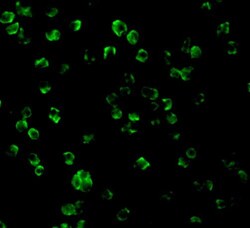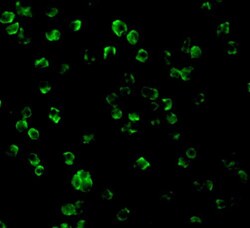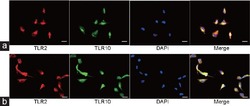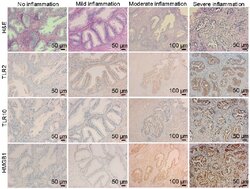Antibody data
- Antibody Data
- Antigen structure
- References [1]
- Comments [0]
- Validations
- Immunocytochemistry [2]
- Other assay [4]
Submit
Validation data
Reference
Comment
Report error
- Product number
- PA5-20054 - Provider product page

- Provider
- Invitrogen Antibodies
- Product name
- TLR10 Polyclonal Antibody
- Antibody type
- Polyclonal
- Antigen
- Synthetic peptide
- Description
- Despite its predicted molecular weight of ~90kDa, TLR10 is observed at ~75kDa in immunoblot assays. A suggested positive control is human lymph node tissue lysate. PA5-20054 can be used with blocking peptide PEP-0173.
- Reactivity
- Human
- Host
- Rabbit
- Isotype
- IgG
- Vial size
- 100 µg
- Concentration
- 1 mg/mL
- Storage
- Maintain refrigerated at 2-8°C for up to 3 months. For long term storage store at -20°C
Submitted references Toll-like receptor 10 (TLR10) exhibits suppressive effects on inflammation of prostate epithelial cells.
Fan Y, Yang L, Wei Q, Ding Y, Tang Z, Tan P, Lin T, Guo D, Qiu S
Asian journal of andrology 2019 Jul-Aug;21(4):393-399
Asian journal of andrology 2019 Jul-Aug;21(4):393-399
No comments: Submit comment
Supportive validation
- Submitted by
- Invitrogen Antibodies (provider)
- Main image

- Experimental details
- Immunofluorescence of TLR10 in Daudi cells with TLR10 Polyclonal Antibody (Product # PA5-20054) at 2 µg/mL.
- Submitted by
- Invitrogen Antibodies (provider)
- Main image

- Experimental details
- Immunofluorescence of TLR10 in Daudi cells with TLR10 Polyclonal Antibody (Product # PA5-20054) at 2 µg/mL.
Supportive validation
- Submitted by
- Invitrogen Antibodies (provider)
- Main image

- Experimental details
- Figure 1 IF staining: the expression of TLR2 and TLR10 in prostate tissue. TLR2 and TLR10 were both found to be expressed in human prostate tissue. Higher TLR2 and TLR10 expressions were observed in prostate glandular epithelium than in stroma, especially TLR10. Scale bars = 50 mm. IF: immunofluorescence; TLR: Toll-like receptor; DAPI: 4',6-diamidino-2-phenylindole. Arrow: an amyloid body in prostatic acinus cavity. Figure 1
- Submitted by
- Invitrogen Antibodies (provider)
- Main image

- Experimental details
- Figure 2 IF staining: the expression of TLR2 and TLR10 in RWPE-1 cells. (a) TLR2 and TLR10 were found to be co-expressed in granular form on plasma membrane of RWPE-1 cells (no Triton(tm) X-100 used: keep integrity of plasma membrane). (b) TLR2 and TLR10 were found to be co-expressed in cytosol of RWPE-1 cells (permeabilization with Triton(tm) X-100: plasma membrane was ruptured). Scale bars = 20 mm. IF: immunofluorescence; TLR: Toll-like receptor; DAPI: 4',6-diamidino-2-phenylindole. Figure 2
- Submitted by
- Invitrogen Antibodies (provider)
- Main image

- Experimental details
- Figure 3 H and E and IHC staining: the expression of TLR2, TLR10, and HMGB1 in prostate tissues with different inflammatory grades. The expression levels of TLR2, TLR10, and HMGB1 were all positively correlated with prostate tissue inflammatory grades. Higher TLR2, TLR10, and HMGB1 expressions were observed in epithelium than in stroma. H and E: hematoxylin and eosin; IHC: immunohistochemistry; TLR: Toll-like receptor; HMGB1: high mobility group box 1. Figure 3
- Submitted by
- Invitrogen Antibodies (provider)
- Main image

- Experimental details
- Figure 1 IF staining: the expression of TLR2 and TLR10 in prostate tissue. TLR2 and TLR10 were both found to be expressed in human prostate tissue. Higher TLR2 and TLR10 expressions were observed in prostate glandular epithelium than in stroma, especially TLR10. Scale bars = 50 mm. IF: immunofluorescence; TLR: Toll-like receptor; DAPI: 4',6-diamidino-2-phenylindole. Arrow: an amyloid body in prostatic acinus cavity.
 Explore
Explore Validate
Validate Learn
Learn Western blot
Western blot Immunocytochemistry
Immunocytochemistry